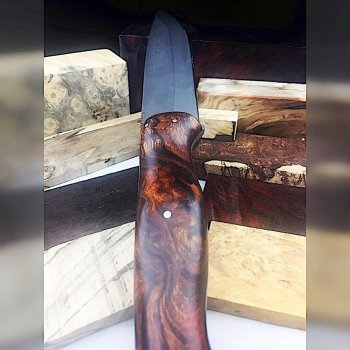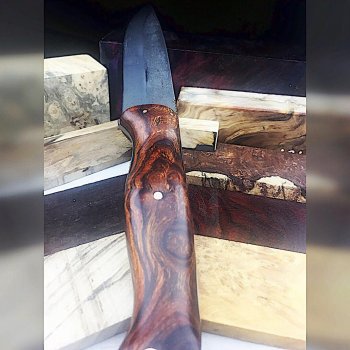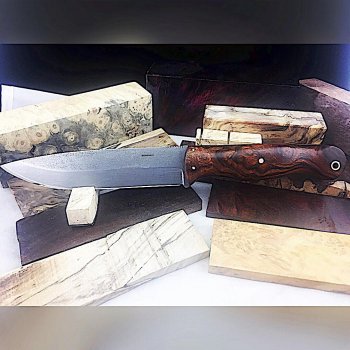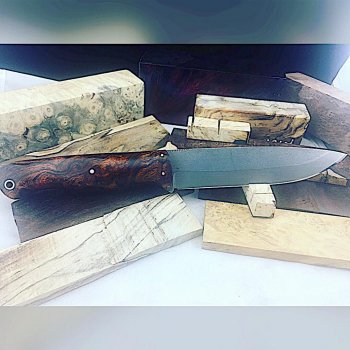You are using an out of date browser. It may not display this or other websites correctly.
You should upgrade or use an alternative browser.
You should upgrade or use an alternative browser.
Iron Wood tips please
- Thread starter wall e
- Start date
EdCaffreyMS
"The Montana Bladesmith"
Everything you use to work it should be SHARP.... bits, files, belts, sandpaper. Ironwood will "burn" easily if belts are not sharp, or if you're running the belt too fast. It will easily clog the flutes on drill bits. Finish wise, the only thing I do with it is take it to a very fine finish (I go to 1200 or more), then a light buff, and finish it off with a good quality paste wax.
wall e
Well-Known Member
Ok SHARP is the key. I may be in trouble on the speed of the belt since I'm still working with the old Sterling 1x42 that has only full speed. I may have to engineer a variable speed switch with out the help of Radio Shack. possibly a 115v dimmer switch?
I don't have any paste wax though. Suggestions?
I don't have any paste wax though. Suggestions?
EdCaffreyMS
"The Montana Bladesmith"
Be careful with trying to speed control with a dimmer switch, it can burn out a motor! Just take your time with the wood and all should be good. For wax, just about any type of furniture or automotive paste wax will work....just don't get anything with silicone in it. Johnson paste wax, Briwax, or something of that nature. Personally I use an auto wax that's available from Walmart..... Mother's California Gold Carnauba cleaner/wax. Many folks like renaissance wax too.
Walt,
Ironwood is maybe the most popular choice of handle wood by veteran knifemakers for a reason. It looks great, it's tough and works well. Ed is right about sharp belts and lower speeds. It will burn. Rough it out and hand sand the final 20%. When I started out knife making, I always thought the better my grinding skills the further I could take a knife. I learned after awhile that finishing a higher quality knife takes more hand work than power tools. Others may have different experience or opinions on that but that's been mine. You can stop at 400 grit but it will benefit from taking it to 1200 to 1500 grit. You can see the difference between the two finishes. Ironwood usually doesn't have an issue with splitting unless it has some inclusions or you are into the really black, rough grain on some pieces. There are dozens (hundreds?) of woods called Ironwood. Some are better than others. Some cuts from the same tree are better than others. Just like all woods. When you pin it to the handle, the pin should slide easily through hole. Put a small notch or two in the middle of the pin for the epoxy to fill and give you a mechanical lock. If the pin is tight in the wood, humidity changes will shrink and swell the wood against the pin and eventually the wood will start to crack. Tight pins in natural materials eventually crack the scales.
Ironwood doesn't need any oil but I do like to finish it with tung oil before waxing and buffing. The oil really helps bring out the grain and chatoyance. I apply it every 5 minutes with a Qtip until it stops soaking into the wood. Then I wipe it off as some weeps back out for another 30 minutes or so. If you get really fancy, wet sand it with 600 grit with the tung oil. The sanding dust will blend in and fill any pores in the wood. Let it cure a day or two and then wax and buff. Pure tung oil takes days/weeks to dry. Something like Deft or Watco Danish (clear) Oil, is mostly tung oil with some evaporants to accelerate curing.
Post up a pic when you get it done.
t
Ironwood is maybe the most popular choice of handle wood by veteran knifemakers for a reason. It looks great, it's tough and works well. Ed is right about sharp belts and lower speeds. It will burn. Rough it out and hand sand the final 20%. When I started out knife making, I always thought the better my grinding skills the further I could take a knife. I learned after awhile that finishing a higher quality knife takes more hand work than power tools. Others may have different experience or opinions on that but that's been mine. You can stop at 400 grit but it will benefit from taking it to 1200 to 1500 grit. You can see the difference between the two finishes. Ironwood usually doesn't have an issue with splitting unless it has some inclusions or you are into the really black, rough grain on some pieces. There are dozens (hundreds?) of woods called Ironwood. Some are better than others. Some cuts from the same tree are better than others. Just like all woods. When you pin it to the handle, the pin should slide easily through hole. Put a small notch or two in the middle of the pin for the epoxy to fill and give you a mechanical lock. If the pin is tight in the wood, humidity changes will shrink and swell the wood against the pin and eventually the wood will start to crack. Tight pins in natural materials eventually crack the scales.
Ironwood doesn't need any oil but I do like to finish it with tung oil before waxing and buffing. The oil really helps bring out the grain and chatoyance. I apply it every 5 minutes with a Qtip until it stops soaking into the wood. Then I wipe it off as some weeps back out for another 30 minutes or so. If you get really fancy, wet sand it with 600 grit with the tung oil. The sanding dust will blend in and fill any pores in the wood. Let it cure a day or two and then wax and buff. Pure tung oil takes days/weeks to dry. Something like Deft or Watco Danish (clear) Oil, is mostly tung oil with some evaporants to accelerate curing.
Post up a pic when you get it done.
t
Last edited:
EdCaffreyMS
"The Montana Bladesmith"
Tracy..... your post gave me an idea! I wonder if a guy could apply the Danish oil in the same manner as Tru-Oil..... super light coat/let it cure and repeat..... I'm gona give it a try and see what happens. I've done the Danish oil finish on others, but never thought of doing it on ironwood! Always something new to learn! 
Justin Presson
Well-Known Member
I can vouch for drill bit flutes clogging. I did it the other day with some ironwood and was not paying attention I guess and ended up splitting the scales by forcing the bit. But I love the stuff it is my favorite wood even though it smells like cat urine when you grind it...lol
Sent from my SM-G920P using Tapatalk
Sent from my SM-G920P using Tapatalk
wall e
Well-Known Member
So which is worse, antler or iron wood?I can vouch for drill bit flutes clogging. I did it the other day with some ironwood and was not paying attention I guess and ended up splitting the scales by forcing the bit. But I love the stuff it is my favorite wood even though it smells like cat urine when you grind it...lol
Sent from my SM-G920P using Tapatalk
Tracy..... your post gave me an idea! I wonder if a guy could apply the Danish oil in the same manner as Tru-Oil..... super light coat/let it cure and repeat..... I'm gona give it a try and see what happens. I've done the Danish oil finish on others, but never thought of doing it on ironwood! Always something new to learn!
Tru-Oil is probably on more custom gunstocks than most anything else other than boiled linseed oil. It's tough as nails and buffs up nicely. (I used to sell it but dropped it.) It is mostly tung oil also but quite a bit more viscous than either the Watco or Deft Danish oils so it doesn't penetrate the dense ironwood like those do. Walnut will take it up fairly well. Tru-Oil will build up in layers easier than Watco/Deft and that is a look that many people really appreciate. I've just never had the patience to take the time to do that. I know Tru-Oil can be thinned but it just takes so darn long to dry I switched to Danish oil.
On a tangent, I did a test a long time ago with Tru-Oil, boiled linseed and Deft Danish oil. I poured a small bit into the bottom of some plastic cups, labeled them and put them on a shelf. A year later the boiled linseed oil had skinned over and was still gummy and wet under the skin. The Tru-Oil shrank away from the edges and turned amber yellow, the danish oil dried to the most clear of the three with no cracking or obvious shrinking. After a couple years, the linseed oil finally cured but cracked into several pieces. Gunstock refinishing is as much of an art as knife making and I know linseed oil and Tru-Oil is used with great success by those guys. I just wasn't able to get what I needed out of them.
AkWildman
Well-Known Member
Hi Walt I totally agree with the obove advice ! When I'm working on a knife handle that is wood or some other exotic material the power tool are left out.I do my ruff shaping with a quality copping saw and final shaping with hand files.It force's you to take your time and you stay in contact with the piece and can really fine tune it.Plus you don't have a oops from a split second mishap on a power saw or belt grinder.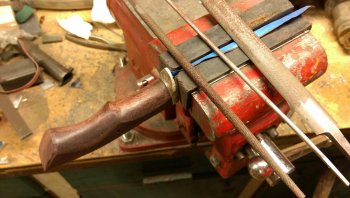



Watco makes a teak oil for dense oily woods. I wonder if that would work on Ironwood. I've used it on Kingwood and Blackwood with success.
I have tried Teak oil and it doesn't seem to give the same finish. Nothing wrong with it, it's just my preference compared to the Danish oil.
EdCaffreyMS
"The Montana Bladesmith"
Over the past several days, I tried using the Watco Teak Oil, as I would Tru-Oil...... super light coat, allow to dry, steel wool, and repeat. It doesn't work out the same. Tru-Oil blends and builds up with each successive coat, but the teak oil never seems to build up.... only so much will "soak" in, and successive coats just sit there and never dry.
BUT! I tried a single light coat of the Teak Oil on both Ironwood and African Blackwood..... As Tracy said, it's a "different" finish....seems more of a "satin", but for these woods I see it as a viable sealer/finish.... for me it will be a great sealer coat for the texturing I do on many knives, I also discovered that you don't want to be buffing anything post application that's been treated with the Teak oil..... even slight heat from gentle buffing causes the Teak Oil to to "leech" out of the wood, and leaves a nasty looking mess. Guess you never know if ya don't try!
That's what I love so much about KD! Somebody brings up something that sends us in a direction we'd otherwise not thought of..... and we learn from it!
BUT! I tried a single light coat of the Teak Oil on both Ironwood and African Blackwood..... As Tracy said, it's a "different" finish....seems more of a "satin", but for these woods I see it as a viable sealer/finish.... for me it will be a great sealer coat for the texturing I do on many knives, I also discovered that you don't want to be buffing anything post application that's been treated with the Teak oil..... even slight heat from gentle buffing causes the Teak Oil to to "leech" out of the wood, and leaves a nasty looking mess. Guess you never know if ya don't try!
That's what I love so much about KD! Somebody brings up something that sends us in a direction we'd otherwise not thought of..... and we learn from it!
busted knuckles
Well-Known Member
Hey guys,
Haven't been on KD for a long while, like years!
But just though I'd drop my $.02.
I haven't tried Danish oil, but if Ed and Tracy use it I may give it a try.
I've had great results with lin seed oil and 0000 steel wool, it really brings out the depth of the wood.
Good luck with your project! Special knife for mom, it's gotta' be pretty!
Haven't been on KD for a long while, like years!
But just though I'd drop my $.02.
I haven't tried Danish oil, but if Ed and Tracy use it I may give it a try.
I've had great results with lin seed oil and 0000 steel wool, it really brings out the depth of the wood.
Good luck with your project! Special knife for mom, it's gotta' be pretty!
wall e
Well-Known Member
I have read and am hearing the advice of the many who have used this wood before as well as those who have been in the custom and unique sector of this hobby for me.
There is both true oil and danish oil in my shop on the shelf in the cave I have. I used danish oil on a coolibah burl for a paring knife and it worked great just didn't seal up like I needed so I tried the true oil. And about 5 coats later it was smooth,sealed and looked wet after 0000 steel wool and light hand buffing with a soft towel.
This is going to be a similar process but is a different wood so will present new challenges for me.
I just spent my allowance on new belts and 220,320 grit sheets for this project. Hehe
I only have a variable speed band saw and run it slow an smooth to not have an oops. I do have files to help with the shaping of the handle. I hope to get started grinding tomorrow since my schedule got switched for this week 2 swing shifts instead of my normal graveyards.
There is both true oil and danish oil in my shop on the shelf in the cave I have. I used danish oil on a coolibah burl for a paring knife and it worked great just didn't seal up like I needed so I tried the true oil. And about 5 coats later it was smooth,sealed and looked wet after 0000 steel wool and light hand buffing with a soft towel.
This is going to be a similar process but is a different wood so will present new challenges for me.
I just spent my allowance on new belts and 220,320 grit sheets for this project. Hehe
I only have a variable speed band saw and run it slow an smooth to not have an oops. I do have files to help with the shaping of the handle. I hope to get started grinding tomorrow since my schedule got switched for this week 2 swing shifts instead of my normal graveyards.



